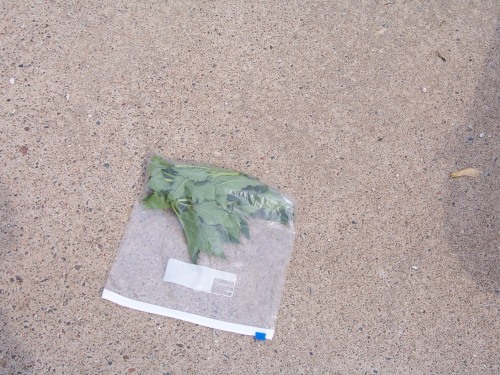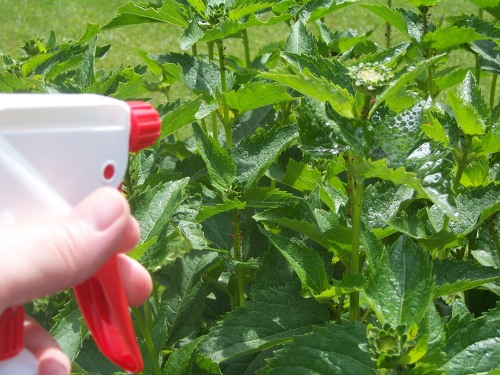This is the third year that I am dealing with red aphids on my perennial sunflower plants. (genus -Helianthus)
” I don’t know why, I never had them before… I only know now that I have them, I don’t want them no more.” (Sorry, it just came to me. Sing it along with me, if you like.)
Aphids have piercing sucking mouthparts and cause tender young leaves to curl and yellow, thus reducing plant vigor and growth. The little creeps also secrete what is called a “honeydew” like substance which is sticky and attracts ants and can cause sooty mold growth on the plants. It’s not attractive.

You usually find them on the underside of a leaf and along the stem of the tender new growth of the plant.

This is a little out of focus, but it gives you a pretty good image of what they look like. Not that you really want to know. On their rear end, they have two pointy things. These are called cornicles and no other insect has them. The honeydew is secreted from the cornicles. Now you really know more than you probably wanted to know.
There are FIVE ways of getting rid of, or more realistically, reducing red aphids, that I know of. Well, I just thought of another one, but it requires squishing them with your fingers and watching your fingers turn all red from their juices…takes too long, anyway.
- Let nature take its course and hopefully you have enough natural predators that will take care of them, such as lady bugs and lace wings. If it looks like a losing battle go to number 2.
- Put a sprayer attachment on the end of your hose and give them a good pressure wash. You can knock many of them off, watch them go hurling off into the air, and I’ve heard they can drown in the water/mud at the base of the plant. I’ve done this, but usually they returned within a day or two. I guess if I repeatedly did this, it could work. Consider number 3.
- Early in the season, usually before the flower buds can be seen – at least this is when I like to do it – I cut off the tender tops that are being infested. Here are some pictures.

Seal up the bag and get rid of it far away from your garden. You can stomp on it first or squish it up with your hands, if you’re that kind of person, but then get rid of it. Just don’t throw it in your neighbor’s yard. That’s not nice.
This methods works pretty well, and I use it early in the season so the plants still have plenty of time to set new flower buds. If the aphids return, here is number four.
4. Soap. You can use insecticidal soap. I don’t. I’m not saying it’s bad or it doesn’t work, I’m just saying I use the natural dish soap we use on our dishes, and it works, so I’m not going out to buy the insecticidal soap. Now, I have read you can use dish soap but not dish detergent, and I have read you can use either. What is the difference? I looked it up for you because I wasn’t sure. I found out that soap is made from natural ingredients such as vegetable oil or animal fat. Detergents are made from petroleum products. So, I’m going with the soap.
O.K., as I was looking at my bottle of “soap” I found that the word “soap” was no where to be found. It is called “natural dish liquid”. Hmmmm, I wonder if you have to have a certain ingredient or there has to be a certain way of processing something before you can legally name something “soap”. This “natural dish liquid,” however, is made of plant derived cleaning agents, and I know from past experience that it has been safe on my plants with this ratio of water/”soap” – 1 tsp. of “soap” per cup of water. So, with my 32 oz. spray bottle, I put in 4 tsp. (or 1 T. and 1 tsp.) of “soap” and filled the rest with water.

Really soak them with the soap. It’s mild enough it won’t hurt the leaves. Do a test run on a small section of the plant if you are uncertain.
O.K., so I did kind of feel badly about doing this to the aphids. Aphids are small and soft-bodied, so the soap works on disrupting their cell membranes and causes dehydration. It’s a quick death, however, from my observations. Fortunately, this soaping down doesn’t work well on all insects including lady bugs, lace wings, or bees. (I feed the lady bugs that I find in my kitchen during the winter – did you know they love a fresh slice of apple?) I have seen this soap method work well, especially if it is applied each time you see the red devils increasing once again in population. (Did you know aphids are born already pregnant with the next generation? It’s true, I’m not making that up.)
5. The last way of getting rid of or reducing the red aphid is through some type of chemical insecticide. As mentioned already, aphids have piercing sucking mouth parts vs. chewing mouth parts. One type of insecticide that can be used is a systemic insecticide that is taken in by the plant and then is sucked out with the plant juices by the aphid. You can apply the systemic insecticide to the soil at the base of the plant. I don’t use chemical insecticides, so I’m no longer up on what is recommended. Go to a good garden center and ask questions about them or read labels carefully if you think you want to use them.
Well, I hope you do well with reducing the red aphid in your garden. By the way, aphids come in all sorts of colors, are found on all sorts of plants. Wooly aphids are the most weird – they look like somebody put a glob of marshmallow cream on their body and then pulled it out into strands. Start looking and most likely you will find an aphid somewhere in your yard. Not all are going to warrant reduction. Insect populations also cycle, meaning you might have a heavy population of one kind for a couple of years and then you won’t see them around for awhile, and then they will cycle back again. So, don’t despair. Overall, I think we can live pretty happily side by side. As long as it’s not in my garden.





